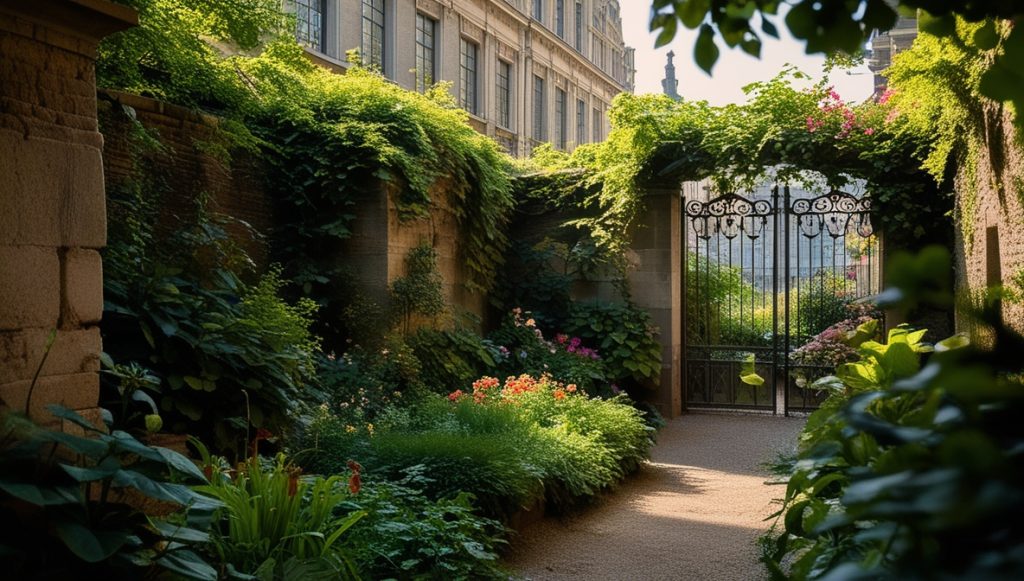In the bustling heart of Antwerp, far removed from the crowds and city sounds, lie hidden gardens and green retreats that offer visitors and locals alike a quiet escape. These spaces, often tucked behind historical walls or concealed in winding alleyways, provide natural sanctuaries in the urban landscape. Each garden tells its own story, blending Antwerp’s rich history with nature’s tranquility. Here are some of the city’s best-kept secret gardens waiting to be explored.
1. Begijnhof Garden
The Begijnhof Garden feels like stepping into another era, a place marked by quietude and history. Established in 1544, this garden was initially part of a community for single women devoted to religious life. Behind tall, ivy-clad brick walls, the space is lush with pear trees, cobblestone paths, and aged statues that hint at its long-standing roots. A stroll through the Begijnhof offers a unique sense of peace, with benches scattered among the greenery for reflection. As you wander here, the garden reveals Antwerp’s layered past, serving as both a historical marker and a refuge from the city’s busy pace.
2. Garden of the Academy
Tucked away on Mutsaardstraat, the Garden of the Academy offers a quiet retreat adorned with student artworks. Originally designed in 1841 as an open-air museum, this space was created to bring art and nature together in harmony. Recently reopened to the public, the garden showcases sculptures and installations crafted by students from Antwerp’s Royal Academy of Fine Arts. The works here change periodically, giving each visit a fresh perspective. The Garden of the Academy remains one of Antwerp’s hidden gems, perfect for a peaceful pause in the middle of the city.
3. Den Botaniek (Antwerp Botanical Garden)
Known as Plantentuin to locals, Den Botaniek is a small botanical garden with over 2,000 plant species and unusual finds that add to its charm. Located near the city center, this green space features a small pond with a cascading waterfall, quirky statues, and seasonal blooms that keep the landscape vibrant year-round. Free to enter, the garden offers a wonderful spot to relax, enjoy the rich biodiversity, and perhaps gain some gardening inspiration. Den Botaniek stands out as an accessible and refreshing oasis, embodying Antwerp’s blend of natural beauty and urban accessibility.
4. Hortus Conclusus
Inspired by paradise gardens, the Hortus Conclusus near St. George’s Church provides a sensory experience filled with color and fragrance. Created by landscape artist Ronald van der Hilst, this reimagined space is marked by various textures and carefully curated plant species. The name, meaning “Enclosed Garden,” reflects its design—a compact, carefully arranged garden ideal for quiet contemplation. Visitors are often treated to herbal infusions made from plants grown in the garden, further deepening the connection to nature. The Hortus Conclusus is a place where artistry and botany meet, resulting in a dynamic yet meditative space.
5. Calvary Garden
Behind St. Paul’s Church lies the Calvary Garden, a serene space adorned with life-sized religious statues and lush greenery. Accessed through a discreet corridor in the church, this garden feels almost hidden in plain sight. Here, quiet corners invite visitors to sit and reflect, while statues of saints add an ethereal quality to the atmosphere. Calvary Garden provides a reprieve from the outside world, making it an ideal spot for those seeking calm in the city. Whether visiting for religious reflection or simply to admire its beauty, Calvary Garden adds depth to Antwerp’s hidden green spaces.
6. Vlaeykensgang
A place where history and nature intertwine, Vlaeykensgang is a narrow alleyway dating back to the 16th century. This space feels like stepping into a storybook, with its charming houses, art galleries, and antique shops lining the way. Though not a traditional garden, Vlaeykensgang offers a sense of hidden beauty that makes it one of Antwerp’s most romantic spots. Ivy and other greenery weave around the walls, creating a natural frame for this quaint and timeless area. Exploring Vlaeykensgang is like discovering a snapshot of Antwerp’s past, kept alive by the charm of its surroundings.
7. Vrijdagmarkt
Though it’s typically bustling with a flea market on Fridays, Vrijdagmarkt transforms into a quiet retreat on other days. With historic architecture surrounding the square, the space invites visitors to enjoy a relaxed ambiance away from Antwerp’s busier streets. Nearby cafes offer views of this lesser-known square, making it easy to sit and appreciate the surroundings. Vrijdagmarkt provides a slice of Antwerp’s local culture, combining elements of history, commerce, and green spaces to create a multifaceted experience.
How to Experience Antwerp’s Secret Gardens
Each of these hidden gardens offers something unique, yet they all share the ability to provide a natural refuge within the city. For those looking to experience Antwerp beyond its more famous landmarks, these secret green spaces deliver on their promise of tranquility, history, and a connection to nature. Whether it’s a leisurely stroll, quiet reflection, or an interest in the stories behind each space, Antwerp’s hidden gardens are worth every moment spent within their walls.
Pro Tips:
- Bring a Book: Many of these gardens have benches and shaded areas perfect for reading or simply soaking in the ambiance.
- Check Visiting Hours: Some gardens may have specific opening times, so it’s helpful to plan your visit accordingly.
- Pack a Snack: Especially for gardens like Den Botaniek, packing a small picnic can enhance your experience, allowing you to linger a little longer.
Conclusion
Antwerp’s hidden gardens reveal a side of the city often overlooked by visitors and locals alike. These parks and green spaces in Antwerp serve not only as peaceful retreats but also as living monuments to the city’s rich history and artistic spirit. From secluded historical gardens to artistic enclaves and botanical collections, each location provides a unique experience that connects nature, heritage, and urban life.


